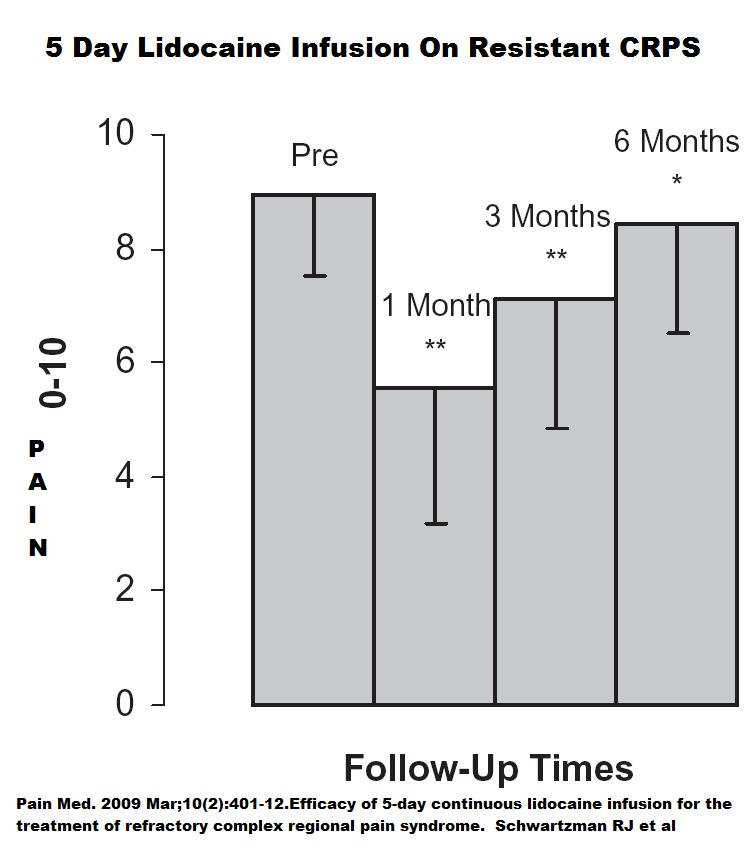One study found a 5 day courses of IV lidocaine useful in both Complex Regional Pain and Peripheral nerve injury neuropathic pain. Other used 1 hour sessions of increasing dose daily for 4 days. Each got good results. When all else fails, at least this is possible. Followup with topical lidocaine promoted long-term results (for how to make your own patches see:
Making Your Own Lidocaine Patches )
Pain Med. 2009 Mar;10(2):401-12.
Efficacy of 5-day continuous lidocaine infusion for the treatment of refractory
complex regional pain syndrome
Schwartzman RJ, Patel M, Grothusen JR, Alexander GM.
Department of Neurology, Drexel University College of Medicine, Philadelphia, Pennsylvania 19111-1839, USA. robert.schwartzman@drexelmed.edu
I have shamelessly left Dr. Schwartzman’s email on the abstract reference as some might want to contact him for sites you can get this done –
Please people – supply sites and costs for others if come across.
Lidocaine protocol:
- contraindications
– allergies to lidocaine,
– seizure disorder
– a history of substance or drug abuse
– psychiatric illness
– cardiac disease or presence of any heart block (even first degree) – need an ECG
– pregnancy
- “2 g of lidocaine in 250 mL of 5% dextrose in water at
- Day 1 – 7.55 cc/h (60.4 mg/h) over the first 24 hours” – in all cases this did not bring up blood levels so might be useful to test tolerance but not to treat
- Day 2 – “11 cc/h over the next 24 hours” – blood levels 1.0-2.9
- Day 3 – “15 cc/h – got Blood lidocaine levels 1.1-4.5 mg/L
- Day 4 – 18 cc/h – levels 1.6-5.1
- Day 5 – 21 cc/h (168.0 mg/h) – levels 0.79- 6.9 (some were obviously adjusted)
- daily blood levels-
– “rate increased only if the blood level was less than 5 mg/L. ”
– “If the blood lidocaine level was greater than 5 mg/L, the rate of infusion was decreased to the rate used on the previous day.” - “If side affects occurred, drop in blood pressure, cardiac arrhythmia, dysphoria, or dizziness, dosage was decreased or stopped. “
- no one tolerated over 21 cc/hr (168 mh/h)
- Results:
Second Reference:
REFRACTORY PERIPHERAL NEUROPATHIC PAIN: INTEREST LOCAL ANESTHETICS (LA) IV FOLLOWED BY TOPICALLY LA VERSUS TOPICAL LA ALONE.
L. L. Brasseur1,2, J. J. Beatrix3, M. M. Giboutet3, A. A. Domec3, N. N. Zrek3, A. A. Khodja3, m. M. sorel3,4, 1Of anesthesia, Rene Huguenin Hosp., Paris, France, 2Paris Ouest Ile of France Univ., Paris, France, 3Pain, Hosp., Nemours, France, 4Paris Xii Univ., Creteil, France
IASP Poster PH 471 Montreal 2010
- Various peripheral nerve injuries:
– plexus nerve injury
– rooting injury
– trunk nerve injury
– some cases CRPS - lidocaine protocol – 4 days: They say “1 hour sessions” each day-
– day 1 – 1 mg/Kg
– day 2 – 2 mg/kg
– day 3 – 4 mg/kg
– day 4 – 5 mg/kg - cardiac monitoring
- 5% lidocaine topical used subsequently
Results
- a decrease VAS and NPSI (neuropathic pain inventory scores) scores >30% were found for 95% (70% with 50% improvement).
- 60% has an Improvement of CGI (severity, index and therapeutic measure) scores
- Responders averaged a 2 year relief
- Response of IV lidocaine helped determine response to topical
- “No adverse effects were encountered”
- Non-responders were tested with scinti-scans to look for inflammatory changes and enthesis and treated with anti-inflammatory agents and ketamine infusions
Comment – this would need either an inpatient or outpatient setting – hard to do in our overflowing hospitals. Effects of lidocaine can wear off if not tempered with common sense. Sadly, I gave daily IV lidocaine treatments to one patient for a month until I ran out of veins, only to find she overdid things subsequently. She moved, and attempted to assume a more independent life without effectively dealing with toxic elements in her family. Things went badly downhill from there. It did spur me on to finding B12 maintenance shots and Ketamine maintainance can control pain in more hopeless situations.


Pingback: Severe Neuropathic Pain – Only 1/4 Respond to Standard Drug Protocols – What Else Is There? | Pain Medical Musing